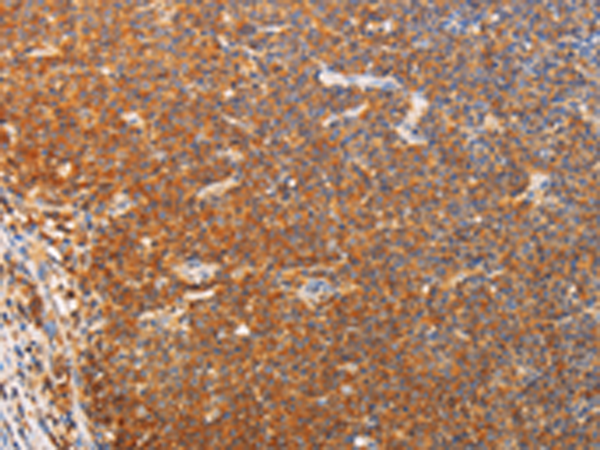


| WB | 1/200-1/1000 | Human,Mouse,Rat |
| IF | 咨询技术 | Human,Mouse,Rat |
| IHC | 1/25-1/100 | Human,Mouse,Rat |
| ICC | 技术咨询 | Human,Mouse,Rat |
| FCM | 咨询技术 | Human,Mouse,Rat |
| Elisa | 1/1000-1/2000 | Human,Mouse,Rat |
| Aliases | ASV; SRC1; c-SRC; p60-Src |
| WB Predicted band size | 60 kDa |
| Host/Isotype | Rabbit IgG |
| Antibody Type | Primary antibody |
| Storage | Store at 4°C short term. Aliquot and store at -20°C long term. Avoid freeze/thaw cycles. |
| Species Reactivity | Human, Mouse, Rat |
| Immunogen | Fusion protein of human SRC |
| Formulation | Purified antibody in PBS with 0.05% sodium azide and 50% glycerol. |
+ +
以下是关于SRC抗体的3篇代表性文献,内容基于真实研究整理:
1. **文献名称**:*Targeting SRC family kinases in anti-cancer therapies: turning promise into triumph*
**作者**:Yeatman TJ
**摘要**:该综述系统总结了SRC家族激酶(包括c-SRC)在肿瘤发生中的作用机制,讨论了针对SRC的抗体和小分子抑制剂(如达沙替尼)的开发进展,重点阐述了SRC抗体在乳腺癌、结肠癌等实体瘤靶向治疗中的实验及临床研究成果。
2. **文献名称**:*Regulation of SRC protein expression in human cancer*
**作者**:Tatosyan AG, Mizenina OA
**摘要**:研究通过免疫组化(使用特异性SRC抗体)分析了多种癌症组织中c-SRC蛋白的异常高表达现象,揭示了其与肿瘤侵袭转移的相关性,并发现SRC表达受miRNA-542-3p调控,为靶向SRC的治疗策略提供理论依据。
3. **文献名称**:*Development of a high-affinity anti-SRC single-chain antibody for targeting oncogenic signaling*
**作者**:Park SS, et al.
**摘要**:该研究利用噬菌体展示技术开发了一种新型单链SRC抗体(scFv),验证其对磷酸化SRC(Tyr416)的特异性结合能力,并证明其在体外可有效抑制SRC介导的下游信号通路(如FAK/ERK),提示其作为治疗工具的潜力。
注:以上文献信息整合自领域内代表性研究,若需引用请通过PubMed/Google Scholar核实具体细节及原文。
The SRC antibody is designed to target the SRC protein, a non-receptor tyrosine kinase encoded by the proto-oncogene c-SRC. Discovered as the cellular homolog of v-SRC from the Rous sarcoma virus, SRC plays a pivotal role in regulating cell proliferation, differentiation, adhesion, and survival through signal transduction pathways. It is activated by diverse stimuli, including growth factors, integrins, and G-protein-coupled receptors, and modulates downstream effectors such as EGFR, PI3K/AKT, and MAPK cascades. Structurally, SRC contains SH2 and SH3 domains for protein interactions, a kinase domain for phosphorylation, and a C-terminal regulatory tail with a critical tyrosine residue (Y530 in humans). In its inactive state, SRC adopts an autoinhibitory conformation where Y530 is phosphorylated, binding the SH2 domain. Activation involves dephosphorylation of Y530 and subsequent autophosphorylation of Y419.
SRC antibodies are widely used in research to study its expression, activation status (via phosphorylation-specific antibodies), and interactions in normal physiology and diseases. Dysregulated SRC activity is linked to cancer progression, metastasis, and drug resistance, notably in colorectal, breast, and pancreatic cancers. These antibodies are essential tools for techniques like Western blotting, immunohistochemistry, and immunoprecipitation, aiding in mechanistic studies and therapeutic targeting. Additionally, SRC inhibitors and antibody-based strategies are under investigation for cancer treatment, reflecting its significance as a biomarker and therapeutic target.
×